Avoid getting scammed by fake "DHL Shipping Document/Invoice Receipt" emails
Phishing/ScamAlso Known As: "DHL Shipping Document/Invoice Receipt" phishing email
Get free scan and check if your device is infected.
Remove it nowTo use full-featured product, you have to purchase a license for Combo Cleaner. Seven days free trial available. Combo Cleaner is owned and operated by RCS LT, the parent company of PCRisk.com.
What kind of email is "DHL Shipping Document/Invoice Receipt"?
Our analysis of the "DHL Shipping Document/Invoice Receipt" email revealed that it is fake. This spam letter is presented as a notification from DHL - a legitimate logistics, courier, delivery, and express mail company. This mail attempts to trick recipients into disclosing their email account log-in credentials through a bogus invoice document.
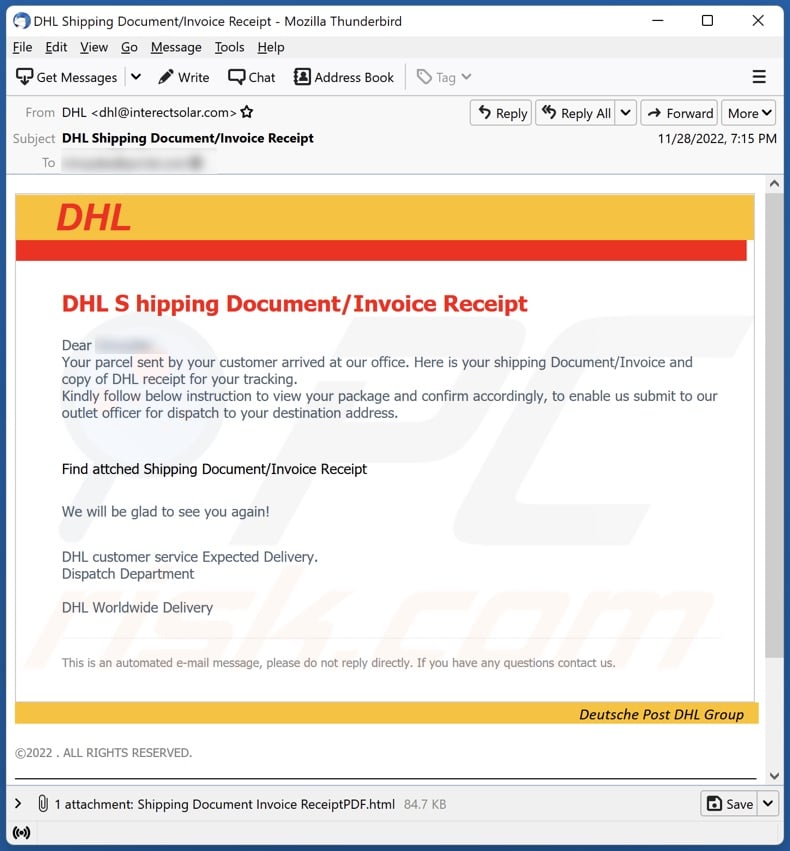
"DHL Shipping Document/Invoice Receipt" email scam overview
The email with the subject "DHL Shipping Document/Invoice Receipt" (may vary) claims that a package for the recipient has arrived at one of DHL's offices. The letter instructs to review the attachment "Shipping Document/Invoice" and provide the necessary confirmation - to have the parcel shipped to the chosen address.
When we inspected the attachment - an HTML file titled "Shipping Document Invoice ReceiptPDF.html" (filename may vary) - we learned that it operated as a phishing file.
The fake invoice stated that only the email recipient can access the shared files - thus, they must enter their mail account log-in credentials (email address and corresponding password). By attempting to view the document and providing said data - users can have their email accounts stolen.
Furthermore, emails are typically used to register other accounts, platforms, services, etc. Hence, the cyber criminals can also steal the content connected in this manner.
To elaborate on how the unauthorized access can be abused, the criminals can assume the identity of social account owners (e.g., emails, social networking, social media, messengers, etc.) and ask the contacts for loans or spread malware by sharing malicious files/links. While finance-related accounts (e.g., online banking, e-commerce, digital wallets, etc.) can be used to make fraudulent transactions or online purchases.
In summary, victims of scam mail like "DHL Shipping Document/Invoice Receipt" can experience severe privacy issues, financial losses, and even identity theft.
If you have already provided your log-in credentials - we advise immediately changing the passwords of all potentially compromised accounts and informing their official support.
| Name | "DHL Shipping Document/Invoice Receipt" phishing email |
| Threat Type | Phishing, Scam, Social Engineering, Fraud |
| Fake Claim | Shipping details must be confirmed to have a parcel shipped to the address chosen by the recipient. |
| Disguise | DHL |
| Attachment(s) | Shipping Document Invoice ReceiptPDF.html (filename may vary) |
| Detection Names (attachment) | Avast (Other:SNH-gen [Phish]), Combo Cleaner (Trojan.Script.GenericKDZ.14039), ESET-NOD32 (HTML/Phishing.Gen), Fortinet (JS/Phishing.6ED6!tr), Kaspersky (HEUR:Hoax.HTML.Phish.gen), Full List Of Detections (VirusTotal) |
| Symptoms | Unauthorized online purchases, changed online account passwords, identity theft, illegal access of the computer. |
| Distribution methods | Deceptive emails, rogue online pop-up ads, search engine poisoning techniques, misspelled domains. |
| Damage | Loss of sensitive private information, monetary loss, identity theft. |
| Malware Removal (Windows) |
To eliminate possible malware infections, scan your computer with legitimate antivirus software. Our security researchers recommend using Combo Cleaner. Download Combo CleanerTo use full-featured product, you have to purchase a license for Combo Cleaner. 7 days free trial available. Combo Cleaner is owned and operated by RCS LT, the parent company of PCRisk.com. |
Phishing spam campaign examples
"Microsoft Request Verification", "Daily Quarantined Message Report", and "Incoming Messages ERROR Notification" are merely a couple examples of phishing spam emails.
This mail is used to facilitate various scams and even proliferate trojans, ransomware, and other malware. These letters can be simple or elaborately disguised as messages from companies, corporations, organizations, authorities, service providers, or other legitimate entities.
Spam mail is widespread - therefore, we highly recommend exercising caution with incoming emails, PMs/DMs, SMSes, and other messages.
How do spam campaigns infect computers?
Spam emails can have virulent files attached to or linked inside them. These files can be Microsoft Office and PDF documents, archives (RAR, ZIP, etc.), executables (.exe, .run, etc.), JavaScript, and so on.
When an infectious file is executed, run, or otherwise opened - the malware download/installation process is triggered. For example, Microsoft Office documents infect devices by executing malicious macro commands.
How to avoid installation of malware?
We advise being careful with incoming mail. The attachments/links found in suspicious emails and messages - must not be opened since that can result in a system infection. Additionally, we recommend using Microsoft Office versions released after 2010, as they have the "Protected View" mode that prevents automatic macro execution.
However, malware is also distributed using other methods. Therefore, we advise downloading only from official/verified sources and activating/updating software using legitimate functions/tools (as illegal activation ["cracking"] tools and third-party updaters can contain malicious programs).
Another recommendation is to be vigilant when browsing since fraudulent and dangerous online content usually appears ordinary/innocuous.
We must stress the importance of having a reputable anti-virus installed and updated. Security software must be used to run regular system scans and to remove threats/issues. If you've already opened malicious attachments, we recommend running a scan with Combo Cleaner Antivirus for Windows to automatically eliminate infiltrated malware.
Text presented in the "DHL Shipping Document/Invoice Receipt" spam email letter:
Subject: DHL Shipping Document/Invoice Receipt
DHL
DHL Shipping Document/Invoice Receipt
Dear -,
Your parcel sent by your customer arrived at our office. Here is your shipping Document/Invoice and copy of DHL receipt for your tracking.
Kindly follow below instruction to view your package and confirm accordingly, to enable us submit to our outlet officer for dispatch to your destination address.
Find attched Shipping Document/Invoice Receipt
We will be glad to see you again!
DHL customer service Expected Delivery.
Dispatch Department
DHL Worldwide Delivery
This is an automated e-mail message, please do not reply directly. If you have any questions contact us.Deutsche Post DHL Group
©2022 . ALL RIGHTS RESERVED.
Screenshot of the phishing file distributed through the "DHL Shipping Document/Invoice Receipt" spam campaign:
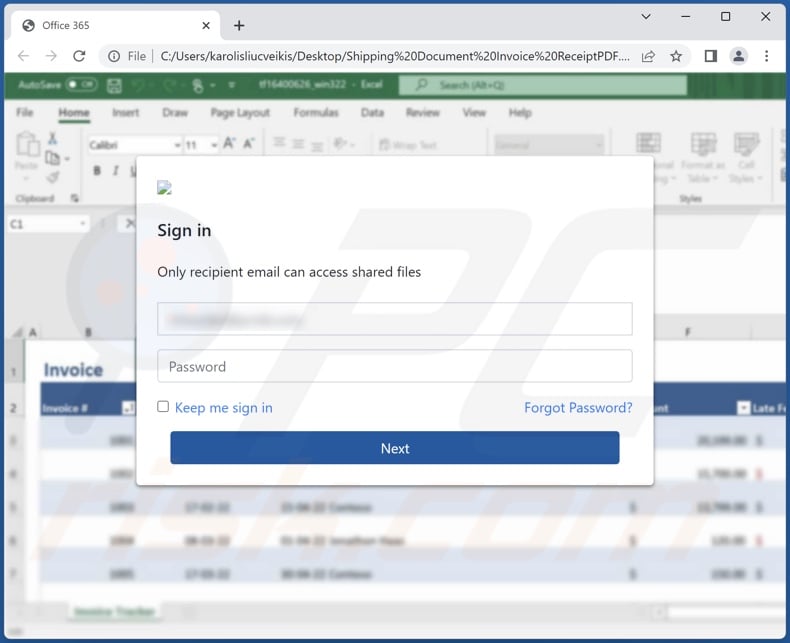
An example of DHL shipping document-themed spam email promoting a phishing site:
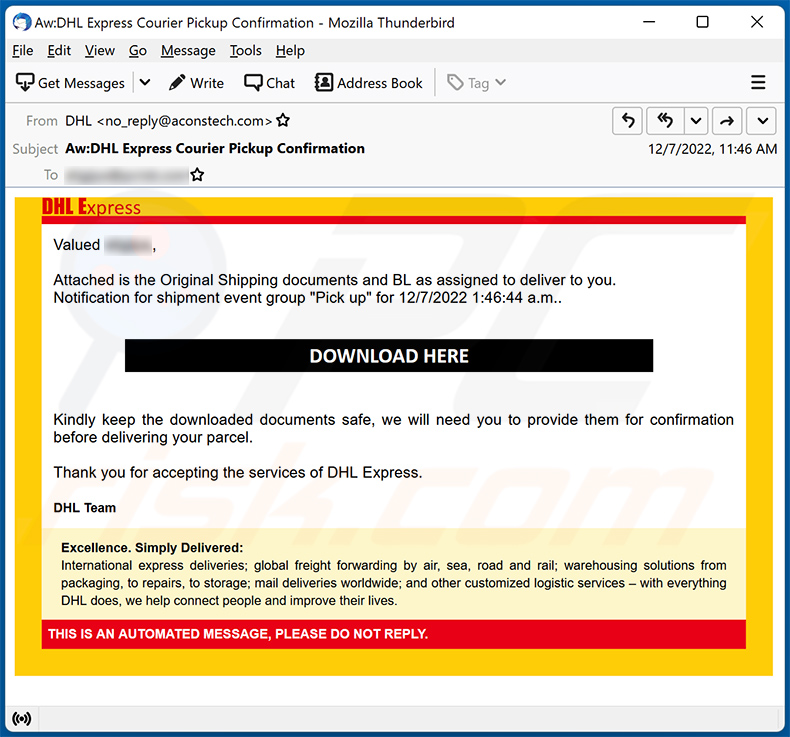
Text presented within:
Subject: Aw:DHL Express Courier Pickup Confirmation
DHL Express
Valued -,Attached is the Original Shipping documents and BL as assigned to deliver to you.
Notification for shipment event group "Pick up" for 12/7/2022 1:46:44 a.m..DOWNLOAD HERE
Kindly keep the downloaded documents safe, we will need you to provide them for confirmation before delivering your parcel.
Thank you for accepting the services of DHL Express.
DHL Team
Excellence. Simply Delivered:
International express deliveries; global freight forwarding by air, sea, road and rail; warehousing solutions from packaging, to repairs, to storage; mail deliveries worldwide; and other customized logistic services – with everything DHL does, we help connect people and improve their lives.
THIS IS AN AUTOMATED MESSAGE, PLEASE DO NOT REPLY.
Screenshot of the promoted phishing site:
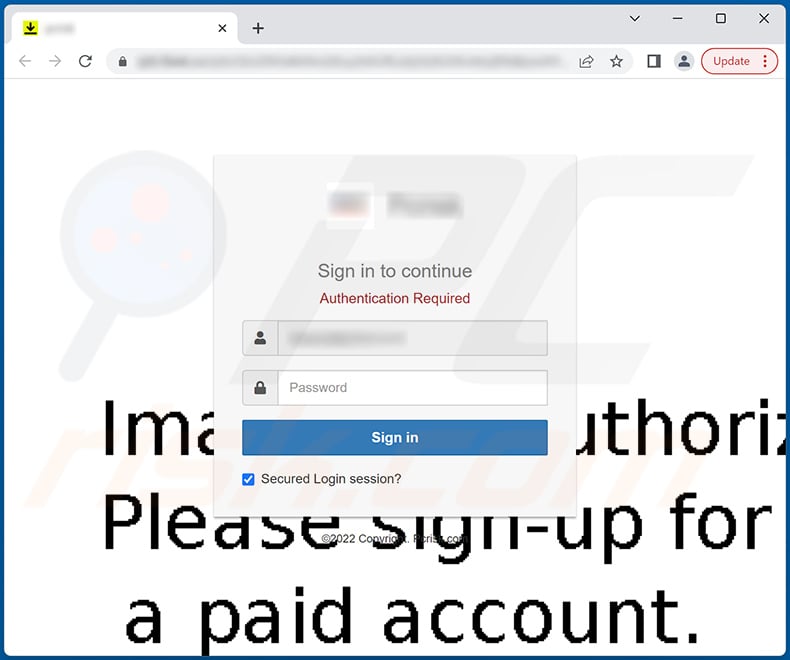
Another example of an email from "DHL Shipping Document/Invoice Receipt" spam campaign:
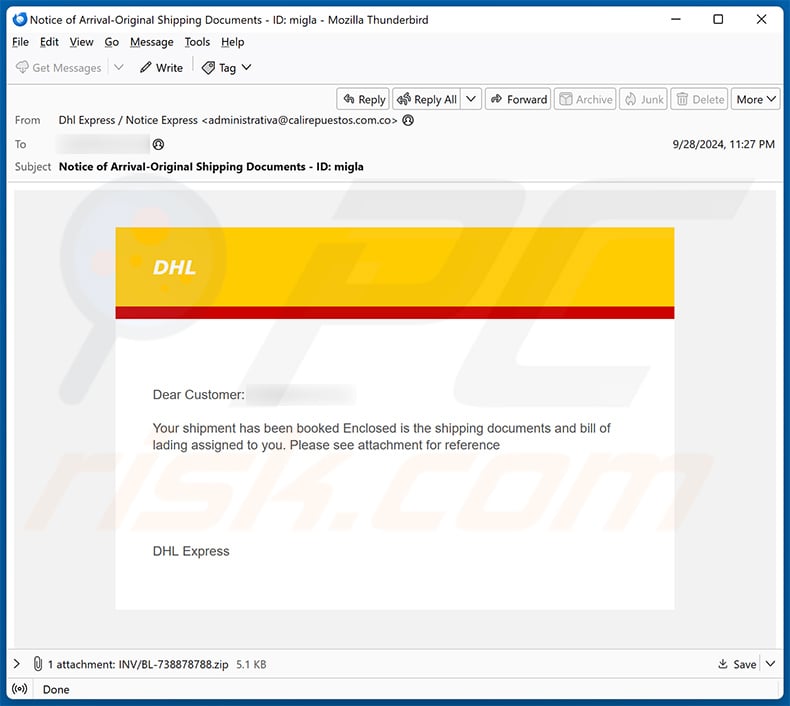
Text presented within:
Subject: Notice of ArrivaI-OriginaI Shipping Documents - ID: ********
DHL
Dear Customer: ********
Your shipment has been booked Enclosed is the shipping documents and bill of lading assigned to you. Please see attachment for reference
DHL Express
Screenshot of the attached HTML document designed for phishing purposes:
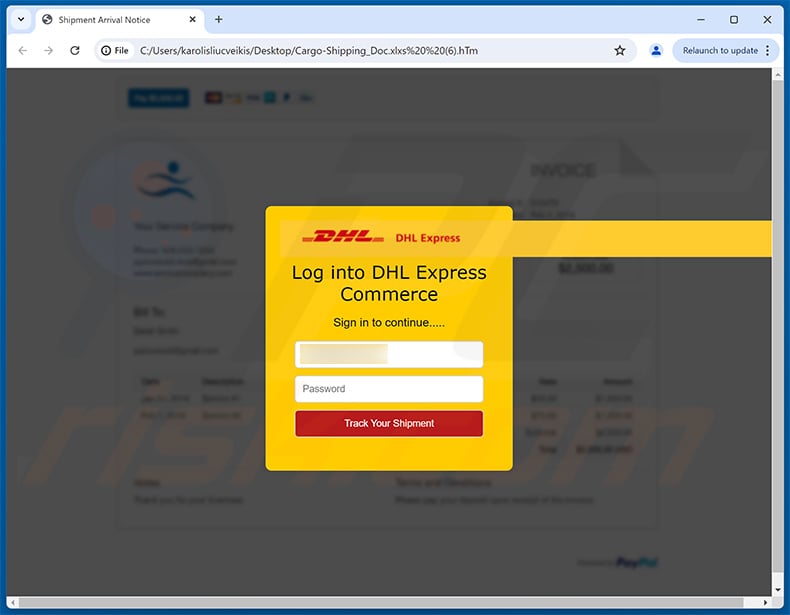
Instant automatic malware removal:
Manual threat removal might be a lengthy and complicated process that requires advanced IT skills. Combo Cleaner is a professional automatic malware removal tool that is recommended to get rid of malware. Download it by clicking the button below:
DOWNLOAD Combo CleanerBy downloading any software listed on this website you agree to our Privacy Policy and Terms of Use. To use full-featured product, you have to purchase a license for Combo Cleaner. 7 days free trial available. Combo Cleaner is owned and operated by RCS LT, the parent company of PCRisk.com.
Quick menu:
- What is "DHL Shipping Document/Invoice Receipt" phishing email?
- Types of malicious emails.
- How to spot a malicious email?
- What to do if you fell for an email scam?
Types of malicious emails:
![]() Phishing Emails
Phishing Emails
Most commonly, cybercriminals use deceptive emails to trick Internet users into giving away their sensitive private information, for example, login information for various online services, email accounts, or online banking information.
Such attacks are called phishing. In a phishing attack, cybercriminals usually send an email message with some popular service logo (for example, Microsoft, DHL, Amazon, Netflix), create urgency (wrong shipping address, expired password, etc.), and place a link which they hope their potential victims will click on.
After clicking the link presented in such email message, victims are redirected to a fake website that looks identical or extremely similar to the original one. Victims are then asked to enter their password, credit card details, or some other information that gets stolen by cybercriminals.
![]() Emails with Malicious Attachments
Emails with Malicious Attachments
Another popular attack vector is email spam with malicious attachments that infect users' computers with malware. Malicious attachments usually carry trojans that are capable of stealing passwords, banking information, and other sensitive information.
In such attacks, cybercriminals' main goal is to trick their potential victims into opening an infected email attachment. To achieve this goal, email messages usually talk about recently received invoices, faxes, or voice messages.
If a potential victim falls for the lure and opens the attachment, their computers get infected, and cybercriminals can collect a lot of sensitive information.
While it's a more complicated method to steal personal information (spam filters and antivirus programs usually detect such attempts), if successful, cybercriminals can get a much wider array of data and can collect information for a long period of time.
![]() Sextortion Emails
Sextortion Emails
This is a type of phishing. In this case, users receive an email claiming that a cybercriminal could access the webcam of the potential victim and has a video recording of one's masturbation.
To get rid of the video, victims are asked to pay a ransom (usually using Bitcoin or another cryptocurrency). Nevertheless, all of these claims are false - users who receive such emails should ignore and delete them.
How to spot a malicious email?
While cyber criminals try to make their lure emails look trustworthy, here are some things that you should look for when trying to spot a phishing email:
- Check the sender's ("from") email address: Hover your mouse over the "from" address and check if it's legitimate. For example, if you received an email from Microsoft, be sure to check if the email address is @microsoft.com and not something suspicious like @m1crosoft.com, @microsfot.com, @account-security-noreply.com, etc.
- Check for generic greetings: If the greeting in the email is "Dear user", "Dear @youremail.com", "Dear valued customer", this should raise suspiciousness. Most commonly, companies call you by your name. Lack of this information could signal a phishing attempt.
- Check the links in the email: Hover your mouse over the link presented in the email, if the link that appears seems suspicious, don't click it. For example, if you received an email from Microsoft and the link in the email shows that it will go to firebasestorage.googleapis.com/v0... you shouldn't trust it. It's best not to click any links in the emails but to visit the company website that sent you the email in the first place.
- Don't blindly trust email attachments: Most commonly, legitimate companies will ask you to log in to their website and to view any documents there; if you received an email with an attachment, it's a good idea to scan it with an antivirus application. Infected email attachments are a common attack vector used by cybercriminals.
To minimise the risk of opening phishing and malicious emails we recommend using Combo Cleaner Antivirus for Windows.
Example of a spam email:

What to do if you fell for an email scam?
- If you clicked on a link in a phishing email and entered your password - be sure to change your password as soon as possible. Usually, cybercriminals collect stolen credentials and then sell them to other groups that use them for malicious purposes. If you change your password in a timely manner, there's a chance that criminals won't have enough time to do any damage.
- If you entered your credit card information - contact your bank as soon as possible and explain the situation. There's a good chance that you will need to cancel your compromised credit card and get a new one.
- If you see any signs of identity theft - you should immediately contact the Federal Trade Commission. This institution will collect information about your situation and create a personal recovery plan.
- If you opened a malicious attachment - your computer is probably infected, you should scan it with a reputable antivirus application. For this purpose, we recommend using Combo Cleaner Antivirus for Windows.
- Help other Internet users - report phishing emails to Anti-Phishing Working Group, FBI’s Internet Crime Complaint Center, National Fraud Information Center and U.S. Department of Justice.
Frequently Asked Questions (FAQ)
Why did I receive this email?
Cyber criminals send emails in massive campaigns with the hopes that at least some recipients will fall for their scams. Spam mail is not personal.
I have provided my personal information when tricked by this spam email, what should I do?
If you have disclosed your log-in credentials - change the passwords of all potentially compromised accounts and inform their official support without delay. And if you've provided other private information (e.g., ID card details, credit card numbers, etc.) - immediately contact the corresponding authorities.
I have read a spam email but didn't open the attachment, is my computer infected?
No, merely reading an email will not result in a system infection. Malware download/installation chains are initiated when malicious attachments or links are opened/clicked.
I have downloaded and opened a file attached to a spam email, is my computer infected?
Whether your device was infected depends on the file's purpose and potentially on its format. When opened, executables (.exe, .run, etc.) infect systems almost without fail. While malicious documents (.doc, .xls, .pdf, etc.) may require additional user interaction (e.g., enabling macro commands) to start downloading/installing malware.
Will Combo Cleaner remove malware infections present in email attachments?
Yes, Combo Cleaner can detect and eliminate most of the known malware infections. It must be stressed that performing a full system scan is essential - since high-end malicious software usually hides deep within systems.
Share:

Tomas Meskauskas
Expert security researcher, professional malware analyst
I am passionate about computer security and technology. I have an experience of over 10 years working in various companies related to computer technical issue solving and Internet security. I have been working as an author and editor for pcrisk.com since 2010. Follow me on Twitter and LinkedIn to stay informed about the latest online security threats.
PCrisk security portal is brought by a company RCS LT.
Joined forces of security researchers help educate computer users about the latest online security threats. More information about the company RCS LT.
Our malware removal guides are free. However, if you want to support us you can send us a donation.
DonatePCrisk security portal is brought by a company RCS LT.
Joined forces of security researchers help educate computer users about the latest online security threats. More information about the company RCS LT.
Our malware removal guides are free. However, if you want to support us you can send us a donation.
Donate
▼ Show Discussion